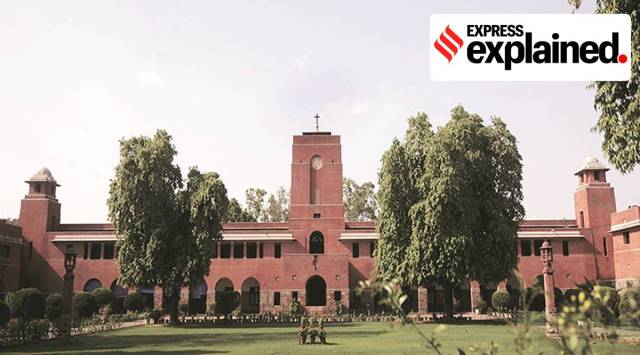Explained: How St Stephen’s admission cut-off list impacts colleges in Delhi University
There has been a rise in the cut-off percentages in all 11 undergraduate courses offered by St Stephen's College. The highest cut-offs are for the BA (Honours) Economics programme at 99.25 per cent.
 As a religious minority institution with 50 per cent seats reserved for Christians, the college has an independent admission system with a separate application form.
As a religious minority institution with 50 per cent seats reserved for Christians, the college has an independent admission system with a separate application form.St Stephen’s College declared its first cut-off list for admission to undergraduate courses on Tuesday. The cut-off is declared before that of other colleges in Delhi University, and is seen as a window into the direction other colleges of the university are expected to take.
What is the increase in cut-offs at St. Stephen’s College?
According to the list released by the college, there has been a rise in the cut-off percentages in all 11 undergraduate courses offered by the college. The highest cut-offs are for the BA (Honours) Economics programme, for which applicants from the commerce stream will require 99.25 per cent or more. Humanities students have a cut-off of 98.75 per cent and science students have 98 per cent. Last year, the cut-offs for the course were 98.75 per cent, 98.5 per cent and 97.75 per cent respectively for the different streams. Commerce students also have 99 per cent cut-offs for B.A. (Honours) History, B.A. (Honours) English and B.A. Programme. Last year, the cut-off was 98.5 per cent, 98.75 per cent and 98 per cent for these courses.
In science stream, PCM (physics, chemistry, and maths) percentage required for Chemistry (Hons) and Physics (Hons) has gone up from 96.33 per cent and 96.66 per cent last year to 96.67 per cent and 97.66 per cent this year respectively.
Check subject-wise cut-off – St Stephen’s College first cut-off
How is the admission system in St. Stephen’s College different from other DU colleges?
As a religious minority institution with 50 per cent seats reserved for Christians, the college has an independent admission system with a separate application form. For admission to other DU colleges, there is a general admission application. While other colleges conduct admission solely through cut-offs, at St. Stephen’s, it is only the first step followed by a written test and interview. However, given the current circumstances with the pandemic, there will be a written test this year and the interviews will be conducted online.
The principal of another DU college – who did not want to be named – said that the high percentages despite the difference in the admission process indicates that the situation is not likely to be any different in other colleges.
“With the interview, they have a mechanism which enables them to not admit more than sanctioned strength of students while we have no admission filter other than the cut-off list, which pushes us to be even more cautious with our lists. Their high cut-offs despite these filters definitely indicates the flow of things,” said the principal.
📣 Express Explained is now on Telegram. Click here to join our channel (@ieexplained) and stay updated with the latest
Does this mean that cut-offs will be higher in all colleges this year?
Colleges prepare their individual cut-off lists on the basis of the applicant data provided to them by the university based on the general admission forms. This data has not yet been sent to the constituent colleges, so the colleges are yet to start preparing their lists.
This year, there has been a huge jump in the number of undergraduate applicants with a total of 3,53,717 applications. Last year, the university had received 2.58 lakh applications for its undergraduate courses. Like every year, the highest number of applicants are from schools affiliated to the CBSE where there has been a sharp increase in the percentage of students who scored above 95 per cent – from 1.47 per cent of the total candidates last year to 3.24 per cent this year.
Hindu College principal Anju Shrivastava said that while the increase in total number of applicants is not likely to affect the cut-offs in a college like hers, the St. Stephen’s cut-offs indicate a high number of applicants with high percentages.
“Our admissions begin and end with students who have the highest percentages and it always comes down to a margin of 2, 3, 4 marks. So it only comes down to the percentages of the highest scorers. The data from their applications on the basis of which St. Stephen’s created its cut-off list indicates the high percentages of the applicants and there is no reason why the same set of applicants won’t apply for general admission,” she said.






































